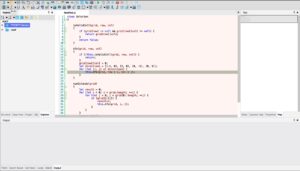CodeLobster IDE: A Comprehensive Review

Overview and Background
Originally launched by CodeLobster Software, this IDE has evolved into a versatile tool that supports a wide range of frameworks such as Drupal, WordPress, Joomla, CakePHP, CodeIgniter, Laravel, Symfony, and Yii, among others. Its freemium model lets developers get started immediately – with no cost for the base version – while offering paid tiers (Lite and Professional) that unlock additional features like enhanced debugging, FTP integration, and more robust plugin support.
Key Features
Multi-Language and Framework Support
- PHP-Centric Development: At its core, CodeLobster IDE is designed for PHP, providing syntax highlighting, auto-completion, and automatic error checking. It further extends support to HTML, CSS, and JavaScript, ensuring that files with mixed content are handled seamlessly.
- Built-In Plugin Ecosystem: The IDE comes with plug-ins for numerous frameworks and CMS platforms (e.g., Drupal, WordPress, Joomla, AngularJS, and more), allowing developers to jump straight into projects without the hassle of manual configuration.
Productivity Tools
- Smart Autocomplete and Contextual Help: CodeLobster’s intelligent auto-completion engine speeds up coding and reduces errors. Contextual help (accessible via the F1 key) fetches documentation directly within the IDE, covering HTML tags, PHP functions, JavaScript methods, and more.
- Robust Debugger: One of the standout features is its built-in PHP debugger. Users can step through code, set breakpoints, and inspect variables in real time – a valuable asset for diagnosing issues in complex web applications.
User Experience and Interface
- Lightweight and Portable: CodeLobster IDE is designed to be fast and occupy minimal disk space, making it ideal for developers who need a responsive and resource-friendly editor. Its customizable interface – with adjustable panels, toolbars, and shortkeys – allows users to tailor the workspace to their personal workflow.
- Cross-Platform Availability: The IDE runs on Windows, macOS, and various Linux distributions, ensuring that it fits into diverse development environments without compromising functionality.
Pros and Cons
Pros
- Comprehensive Feature Set: With built-in support for multiple languages, frameworks, and CMS platforms, CodeLobster is a robust tool for web development.
- Effective Debugging Tools: The integrated PHP debugger and context-sensitive help system help to reduce development time and improve code quality.
- Lightweight and Fast: Its minimalistic design and low resource usage make it particularly attractive for those with older hardware or who prefer a streamlined coding experience.
- Customizable Environment: Developers can adjust themes, toolbars, and shortcuts to suit their workflow, which is especially beneficial for teams working on collaborative projects.
Cons
- User Interface Limitations: Several reviewers note that the interface can feel dated or clunky compared to modern IDEs like Visual Studio Code or PHPStorm. The learning curve might be steeper for beginners who are used to more polished UIs.
- Feature Gaps for Novices: While advanced users appreciate its power, beginners may find some of the workflow nuances less intuitive, particularly when it comes to customizing certain shortcuts or interface elements.
- Limited Free Version: The free version is robust, but after a trial period (or for access to certain advanced features), developers might need to upgrade to the paid Professional version.
Comparison with Other IDEs
Compared to heavyweight options like PHPStorm, CodeLobster offers a more lightweight alternative that is quicker to launch and easier on system resources. Its built-in support for a multitude of frameworks without requiring extensive plugin installation is a key selling point. However, if you prioritize a modern user interface with a polished design, you might find some aspects of CodeLobster lacking. For many, the balance between functionality and speed makes it a compelling option, especially for those who favor an IDE developed by a smaller company not tied to a tech giant.
Deep Dive into CodeLobster’s Features
PHP Development Capabilities
CodeLobster’s PHP support is extensive and includes:
- Syntax Highlighting: Automatic coloring of PHP code elements for improved readability.
- Code Folding: Ability to collapse and expand code blocks for better organization.
- Real-time Error Detection: Immediate feedback on syntax errors as you type.
- PHP Code Completion: Intelligent suggestions for PHP functions, classes, and variables.
- PHP Documentation: Instant access to PHP manual entries for functions and classes.
Here’s an example of how CodeLobster’s PHP autocompletion might work:
<?php
$str = "Hello, World!";
$len = str // At this point, CodeLobster would suggest string functions
// Selecting strlen() from the suggestions:
$len = strlen($str); // CodeLobster completes the function and adds parentheses
echo $len; // Outputs: 13
?>HTML, CSS, and JavaScript Support
Beyond PHP, CodeLobster provides robust support for front-end technologies:
- HTML: Tag completion, attribute suggestions, and live preview capabilities.
- CSS: Property autocompletion, color picker integration, and syntax checking.
- JavaScript: Syntax highlighting, code completion for native JS functions and popular libraries.
An example of HTML autocompletion in CodeLobster:
<!-- As you type, CodeLobster suggests and completes tags -->
<div>
<h1>Welcome to My Website</h1>
<p>This is a paragraph.</p>
<img s // CodeLobster would suggest 'src' attribute
<img src="" a // Now it suggests 'alt' attribute
<img src="image.jpg" alt="An example image">
</div>Framework and CMS Integration
CodeLobster’s framework support is one of its standout features. It includes:
- WordPress: Built-in functions for theme and plugin development.
- Drupal: Hooks autocompletion and module development support.
- Laravel: Blade template syntax highlighting and Artisan command integration.
- Symfony: Twig template support and bundle development tools.
- Vue.js and React: Component autocompletion and syntax support for modern JavaScript frameworks.
Example of Laravel Blade template autocompletion in CodeLobster:
@extends('layouts.app')
@section('content')
<h1>{{ $title }}</h1>
@foreach($items as $item)
<p>{{ $item->name }}</p>
@endforeach
@if // CodeLobster suggests Blade directives
@if($condition)
<p>Condition is true</p>
@endif
@endsectionDatabase Integration
CodeLobster offers database tools that can significantly streamline development:
- SQL Query Builder: Visual interface for constructing complex SQL queries.
- Database Viewer: Browse and edit database contents directly within the IDE.
- Schema Visualization: View table relationships and structure graphically.
Version Control Integration
While not as robust as some dedicated IDEs, CodeLobster does offer basic version control integration:
- Git Support: Commit, push, pull, and merge directly from the IDE.
- SVN Integration: Basic Subversion operations for those using older version control systems.
Debugging Capabilities
CodeLobster’s debugging features are particularly strong for PHP development:
- Xdebug Integration: Set breakpoints, step through code, and inspect variables in real-time.
- Watch Expressions: Monitor specific variables or expressions during debugging sessions.
- Call Stack Analysis: Examine the sequence of function calls leading to the current point of execution.
Example of setting up a debug session in CodeLobster:
<?php
function calculateTotal($price, $quantity) {
$total = $price * $quantity; // Set a breakpoint on this line
return $total;
}
$price = 10;
$quantity = 5;
$result = calculateTotal($price, $quantity);
echo "Total: $result";
?>In this scenario, you could set a breakpoint on the line where $total is calculated, run the debugger, and inspect the values of $price and $quantity as they enter the function.
Performance and System Requirements
One of CodeLobster’s selling points is its lightweight nature. Here are some key performance aspects:
- Minimal System Requirements: Can run smoothly on older hardware, making it accessible to a wide range of developers.
- Quick Startup Time: Launches faster than many competing IDEs, allowing for quick edits and checks.
- Low Memory Footprint: Uses less RAM compared to more feature-heavy IDEs, leaving more resources for other development tools or virtual machines.
Typical system requirements for CodeLobster:
- Operating System: Windows 7 or later, macOS 10.12 or later, Linux (various distributions)
- Processor: 1 GHz or faster
- RAM: 2 GB (4 GB recommended)
- Disk Space: 200 MB for installation
Customization and Extensibility
While not as extensible as some open-source IDEs, CodeLobster does offer several customization options:
- Theme Customization: Adjust colors and styles to reduce eye strain and match personal preferences.
- Keyboard Shortcuts: Modify existing shortcuts or create new ones for frequently used commands.
- Snippets: Create and manage code snippets for rapid insertion of commonly used code blocks.
- Plugins: While not as extensive as some IDEs, CodeLobster does support plugins for additional functionality.
Learning Curve and Documentation
For developers new to CodeLobster, the learning curve can vary:
- Intuitive for PHP Developers: Those familiar with PHP will find many features immediately accessible.
- Documentation: Comprehensive user manual and online resources are available, though some users report that certain advanced features could use more detailed explanations.
- Community Support: While not as large as some IDE communities, CodeLobster has an active forum where users can seek help and share tips.
Pricing Structure
CodeLobster offers a tiered pricing model:
- Free Version: Includes basic PHP, HTML, CSS, and JavaScript support.
- Lite Version: Adds FTP/SFTP support and some additional plugins.
- Professional Version: Unlocks all features including full framework support and advanced debugging tools.
The exact pricing can vary, so it’s best to check the official website for the most current information. Many users find that the free version is sufficient for smaller projects, while the Professional version offers good value for more complex development needs.
User Testimonials and Community Feedback
User opinions on CodeLobster are generally positive, with many appreciating its balance of features and performance:
“CodeLobster has been my go-to IDE for PHP projects for years. It’s fast, reliable, and has all the features I need without the bloat of larger IDEs.” – Sarah K., Web Developer
“The built-in support for WordPress development is a huge time-saver. I can jump into theme customization without any setup hassle.” – Michael R., Freelance Developer
“While the UI took some getting used to, the performance and stability of CodeLobster have won me over. It’s become an essential tool in my development workflow.” – Alex T., Full Stack Developer
Final Thoughts
CodeLobster IDE is a practical, efficient, and feature-rich option for PHP and web development. It excels in offering out-of-the-box support for numerous frameworks and CMS platforms, enabling rapid project setup and debugging. While its interface might not be as modern as some competitors and may require an initial investment in learning its nuances, its performance and robust feature set make it a worthy contender in the crowded IDE market.
If you’re searching for a tool that strikes a balance between a lightweight code editor and a full-fledged IDE – with powerful debugging, intuitive auto-complete, and comprehensive framework support – CodeLobster is definitely worth a try. Its ability to handle complex PHP projects while remaining responsive on older hardware sets it apart in a field where resource-hungry IDEs are becoming increasingly common.
Whether you’re a seasoned PHP developer looking for a more streamlined tool or a beginner seeking an accessible entry point into web development, CodeLobster offers a compelling package that deserves consideration. As with any development tool, the best approach is to take advantage of the free version and evaluate how well it fits into your specific workflow and project needs.


